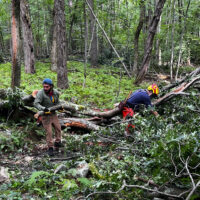Every fifteen minutes, 24/7, the US Geological Survey stream monitoring station on Nashoba Brook in Acton reports how much water is flowing through the brook. Since monitoring began sixty years ago, the highest streamflow ever recorded on December 18 was 99 cubic feet per second (cfs). In this week’s storm, the brook blasted through that record, maxing out at 353 cfs.
By Tuesday morning, the water level was lapping against the base of the footbridge on the Trail through Time. The brook had broken out of its banks and flooded most of the way to the parking lot.


A few hundred feet upstream, water roared across the dam at the base of Robbins Mill Pond.
Across eastern Massachusetts, 2023 has been an exceptionally wet and rainy year. The typical pattern of streamflow for our local streams is high water levels in the winter and spring, followed by much lower water levels in the summer and fall. This year, the low water levels never happened. Winter-like levels of streamflow persisted through July, August and September. Yet even by the standards of this exceptionally wet year, the streamflow peak of December 18 and 19 stood out.

The storm tapered off on Monday afternoon. Yet Nashoba Brook continued to rise, until finally it crested at 5:30am on Tuesday morning. Between falling from the sky and finding its way into a brook or stream, stormwater flows across the landscape, ponding in depressions, roaring along roads, paths and sidewalks — as was apparent to anyone driving or walking around town on Monday.
Throughout Acton, an elaborate and often unnoticed infrastructure system tries to steer stormwater towards a brook or wetland in a way that will minimize harm to people, vehicles, roads and buildings. According to Acton’s recently completed Stormwater Asset Management Plan, there are 174 culverts in town, designed to allow water to pass underneath a road, trail, driveway or railroad. The same report tabulates that the Town owns and operates approximately eighty-four miles of storm drains, 1,698 manholes, 3,511 catch basins and 511 outfalls. Outfalls are places where stormwater leaves the built environment and discharges into a natural body of water — such as Nashoba Brook.
Because stormwater carries pollution, the federal Environmental Protection Agency and the Massachusetts Department of Environmental Protection require municipalities that discharge stormwater into the “waters of the Commonwealth” to have a Municipal Separate Storm Sewer Systems permit, also called an MS4 permit. “Separate” refers to systems (like Acton’s) where stormwater runs through a separate set of pipes from the municipal sewer system.
Acton’s MS4 permit is due for renewal, and thus residents and taxpayers can expect to hear more about stormwater in coming months and years. The Woodard & Curran consultants who prepared Acton’s Stormwater Asset Management Plan this year assessed 20% of the municipally-owned culverts as in need of immediate action or high priority for action, and mapped many corroded, cracked or leaking components throughout the system. The consultants developed an “opinion of probable cost” for various scenarios; the ten year scenario for priority capital improvements plus annual maintenance runs about one million dollars per year.
Looking back through the sixty year history of streamflow at Nashoba Brook, there seem to have been approximately five events with streamflow higher than this week. Looking toward the future, the Climate Change section of the Acton Stormwater Plan shows an upward trend in the number of days per year forecast to receive more than one inch of precipitation. By comparison, this week’s storm dropped approximately 4.1 inches of rain across two days, according to Community Collaborative Rain, Snow and Hail Network (CoCoRHaS) rain gages in Acton.
Kim Kastens is a member of the Acton Exchange Board of Directors. She chairs the Water Committee for Green Acton, and volunteers as a water quality monitor for OARS and as a precipitation observer for CoCoRHaS.


